Modeling of Severe Plastic Deformation by HSHPT of As-Cast Ti-Nb-Zr-Ta-Fe-O Gum Alloy for Orthopedic Implant
Abstract
1. Introduction
2. Materials and Methods
3. HSHPT Modelling
3.1. Simulation Setup
- Considered material is isotropic;
- Heat transfer between bodies in this simulation was done by conduction;
- Heat transfer coefficient between the sample and punch as well as between sample and die was set to 450 W/m2/°C;
- Heat transfer was assumed to occur in all three directions (X, Y, Z);
- Mechanical and physical material properties (Figure 3) vary with temperature (Young modulus, Poisson coefficient, density and specific heat).
- The friction conditions between the surfaces of the sample and the dies were considered to be shear with a coefficient of 0.1;
3.2. Theory—Basic Equations
4. Results and Discussion
5. Conclusions
- A finite element model was developed for the simulation of the severe plastic deformation process based on the following hypotheses: the base material was considered isotropic and its physical characteristics depended on temperature;
- In the simulation of the deformation process, the total analysis time was considered as the time recorded during the physical HSHPT process;
- The variations of the Von Mises stress and the total equivalent strain in five points during the deformation process were plotted;
- The variations of the Von Mises stress and of the deformations along some curves on the surface of the workpiece were drawn at different time intervals.
Supplementary Materials
Author Contributions
Funding
Institutional Review Board Statement
Informed Consent Statement
Data Availability Statement
Acknowledgments
Conflicts of Interest
References
- Valiev, R.Z. Producing bulk nanostructured metals and alloys by severe plastic deformation (SPD). Nanostructured Met. Alloy. Process. Microstruct. Mech. Prop. Appl. 2011, 3–39. [Google Scholar] [CrossRef]
- Valiev, R.Z.; Islamgaliev, R.K.; Alexandrov, I.V. Bulk nanostructured materials from severe plastic deformation. Prog. Mater. Sci. 2000, 45, 103–189. [Google Scholar] [CrossRef]
- Valiev, R.Z. Paradoxes of severe plastic deformation. Adv. Eng. Mater. 2003, 5, 296–300. [Google Scholar] [CrossRef]
- Segal, V. materials Review: Modes and Processes of Severe Plastic Deformation (SPD). Materials 2018, 11, 1175. [Google Scholar] [CrossRef] [PubMed]
- An, X.H.; Wu, S.D.; Zhang, Z.F.; Figueiredo, R.B.; Gao, N.; Langdon, T.G. Enhanced strength–ductility synergy in nanostructured Cu and Cu–Al alloys processed by high-pressure torsion and subsequent annealing. Scr. Mater. 2012, 66, 227–230. [Google Scholar] [CrossRef]
- Estrin, Y.; Vinogradov, A. Extreme grain refinement by severe plastic deformation: A wealth of challenging science. Acta Mater. 2013, 61, 782–817. [Google Scholar] [CrossRef]
- Valiev, R.Z.; Alexandrov, I.V.; Zhu, Y.T.; Lowe, T.C. Paradox of Strength and Ductility in Metals Processed Bysevere Plastic Deformation. J. Mater. Res. 2002, 17, 5–8. [Google Scholar] [CrossRef]
- Valiev, R.Z.; Langdon, T.G. Principles of equal-channel angular pressing as a processing tool for grain refinement. Prog. Mater. Sci. 2006, 51, 881–981. [Google Scholar] [CrossRef]
- Akamatsu, H.; Fujinami, T.; Horita, Z.; Langdon, T.G. Influence of rolling on the superplastic behavior of an Al-Mg-Sc alloy after ECAP. Scr. Mater. 2001, 44, 759–764. [Google Scholar] [CrossRef]
- Iwahashi, Y.; Wang, J.; Horita, Z.; Nemoto, M.; Langdon, T.G. Principle of equal-channel angular pressing for the processing of ultra-fine grained materials. Scr. Mater. 1996, 35, 143–146. [Google Scholar] [CrossRef]
- Tolaminejad, B.; Hoseini Athar, M.M.; Arabi, H.; Karimi Taheri, A. Enhanced grain refinement of commercial pure copper using the ECAE of Al–Cu–Al tri-layer composite. Eng. Sci. Technol. Int. J. 2016, 19, 254–259. [Google Scholar] [CrossRef]
- Tong, Y.X.; Jiang, P.C.; Chen, F.; Tian, B.; Li, L.; Zheng, Y.F.; Gunderov, D.V.; Valiev, R.Z. Microstructure and martensitic transformation of an ultrafine-grained TiNiNb shape memory alloy processed by equal channel angular pressing. Intermetallics 2014, 49, 81–86. [Google Scholar] [CrossRef]
- Zhilyaev, A.P.; Langdon, T.G. Using high-pressure torsion for metal processing: Fundamentals and applications. Prog. Mater. Sci. 2008, 53, 893–979. [Google Scholar] [CrossRef]
- Lin, H.K.; Li, G.Y.; Mortier, S.; Bazarnik, P.; Huang, Y.; Lewandowska, M.; Langdon, T.G. Processing of CP-Ti by high-pressure torsion and the effect of surface modification using a post-HPT laser treatment. J. Alloys Compd. 2019, 784, 653–659. [Google Scholar] [CrossRef]
- Edalati, K.; Horita, Z. A review on high-pressure torsion (HPT) from 1935 to 1988. Mater. Sci. Eng. A 2016, 652, 325–352. [Google Scholar] [CrossRef]
- Gurǎu, G.; Gurǎu, C.; Potecaşu, O.; Alexandru, P.; Bujoreanu, L.G. Novel high-speed high pressure torsion technology for obtaining Fe-Mn-Si-Cr shape memory alloy active elements. J. Mater. Eng. Perform. 2014, 23, 2396–2402. [Google Scholar] [CrossRef]
- Resnina, N.; Belyaev, S.; Zeldovich, V.; Pilyugin, V.; Frolova, N.; Glazova, D. Variations in martensitic transformation parameters due to grains evolution during post-deformation heating of Ti-50.2 at.% Ni alloy amorphized by HPT. Thermochim. Acta 2016, 627–629, 20–30. [Google Scholar] [CrossRef]
- Zhilyaev, A.P.; Lee, S.; Nurislamova, G.V.; Valiev, R.Z.; Langdon, T.G. Microhardness and microstructural evolution in pure nickel during high-pressure torsion. Scr. Mater. 2001, 44, 2753–2758. [Google Scholar] [CrossRef]
- Alizadeh, R.; Mahmudi, R.; Ngan, A.H.W.; Huang, Y.; Langdon, T.G. Superplasticity of a nano-grained Mg-Gd-Y-Zr alloy processed by high-pressure torsion. Mater. Sci. Eng. A 2016, 651, 786–794. [Google Scholar] [CrossRef]
- Saito, Y.; Utsunomiya, H.; Tsuji, N.; Sakai, T. Novel ultra-high straining process for bulk materials development of the accumulative roll-bonding (ARB) process. Acta Mater. 1999, 47, 579–583. [Google Scholar] [CrossRef]
- Takata, N.; Lee, S.H.; Lim, C.Y.; Kim, S.S.; Tsuji, N. Nanostructured bulk copper fabricated by accumulative roll bonding. J. Nanosci. Nanotechnol. 2007, 7, 3985–3989. [Google Scholar] [CrossRef]
- Tayyebi, M.; Rahmatabadi, D.; Adhami, M.; Hashemi, R. Influence of ARB technique on the microstructural, mechanical and fracture properties of the multilayered Al1050/Al5052 composite reinforced by SiC particles. J. Mater. Res. Technol. 2019, 8, 4287–4301. [Google Scholar] [CrossRef]
- Quadir, M.Z.; Duan, J.Q.; Xu, W.; Ferry, M. Structural Refinement, Recrystallization and Grain Growth Phenomena in an Accumulative Roll Bonded Nickel Sheet. Procedia Eng. 2017, 184, 30–34. [Google Scholar] [CrossRef]
- Bagherpour, E.; Pardis, N.; Reihanian, M.; Ebrahimi, R. An overview on severe plastic deformation: Research status, techniques classification, microstructure evolution, and applications. Int. J. Adv. Manuf. Technol. 2019, 100, 1647–1694. [Google Scholar] [CrossRef]
- Gurau, G.; Bujoreanu, L.; Potecasu, O.; Cananau, N.; Alexandru, P.; Gurau, C.; Tanase, D. Process and Machine for Deforming Taper-Shaped Active Elements Made of Shape-Memory Materials by Twisting upon High. Pressure. Patent RO129900, 30 December 2016. [Google Scholar]
- Xie, K.Y.; Wang, Y.; Zhao, Y.; Chang, L.; Wang, G.; Chen, Z.; Cao, Y.; Liao, X.; Lavernia, E.J.; Valiev, R.Z.; et al. Nanocrystalline -Ti alloy with high hardness, low Young’s modulus and excellent in vitro biocompatibility for biomedical applications. Mater. Sci. Eng. C 2013, 33, 3530–3536. [Google Scholar] [CrossRef] [PubMed]
- Iizuka, T.; Lindqvist, C. Changes in C-Reactive Protein Associated with Surgical Treatment of Mandibular Fractures. J. Cranio-Maxillofac. Surg. 2008, 36, 2008. [Google Scholar] [CrossRef] [PubMed]
- Elias, C.N.; Meyers, M.A.; Valiev, R.Z.; Monteiro, S.N. Ultrafine grained titanium for biomedical applications: An overview of performance. J. Mater. Res. Technol. 2013, 2, 340–350. [Google Scholar] [CrossRef]
- Özbeyaz, K.; Kaya, H.; Kentli, A. Novel SPD Method: Twisted Variable Channel Angular Extrusion. Met. Mater. Int. 2022, 28, 1290–1305. [Google Scholar] [CrossRef]
- Pereira, P.H.R.; Figueiredo, R.B. Finite element modelling of high-pressure torsion: An overview. Mater. Trans. 2019, 60, 1139–1150. [Google Scholar] [CrossRef]
- Hassanamraji, N.; Eivani, A.R.; Aboutalebi, M.R. Finite element simulation of deformation and heat transfer during friction stir processing of as-cast AZ91 magnesium alloy. J. Mater. Res. Technol. 2021, 14, 2998–3017. [Google Scholar] [CrossRef]
- Zergani, A.; Mirzadeh, H.; Mahmudi, R. Finite element analysis of plastic deformation in shear punch test. Mater. Lett. 2021, 284. [Google Scholar] [CrossRef]
- Gurau, C.; Gurau, G.; Mitran, V.; Dan, A.; Cimpean, A. The Influence of Severe Plastic Deformation on Microstructure and in Vitro Biocompatibility of the New Ti-Nb-Zr-Ta-Fe-O Alloy Composition. Materials 2020, 13, 4853. [Google Scholar] [CrossRef]
- Kuroda, D.; Niinomi, M.; Morinaga, M.; Kato, Y.; Yashiro, T. Design and mechanical properties of new type titanium alloys for implant materials. Mater. Sci. Eng. A 1998, 243, 244–249. [Google Scholar] [CrossRef]
- Miura, K.; Yamada, N.; Hanada, S.; Jung, T.-K.; Itoi, E. The bone tissue compatibility of a new Ti-Nb-Sn alloy with a low Young’s modulus. Acta Biomater. 2011, 7, 2320–2326. [Google Scholar] [CrossRef]
- Kopova, I.; Stráský, J.; Harcuba, P.; Landa, M.; Janeček, M.; Bačákova, L. Newly developed Ti–Nb–Zr–Ta–Si–Fe biomedical beta titanium alloys with increased strength and enhanced biocompatibility. Mater. Sci. Eng. C 2016, 60, 230–238. [Google Scholar] [CrossRef]
- Weng, W.; Biesiekierski, A.; Li, Y.; Wen, C. Effects of selected metallic and interstitial elements on the microstructure and mechanical properties of beta titanium alloys for orthopedic applications. Materialia 2019, 6, 100323. [Google Scholar] [CrossRef]
- Sandu, A.V.; Baltatu, M.S.; Nabialek, M.; Savin, A.; Vizureanu, P. Characterization and Mechanical Proprieties of New TiMo Alloys Used for Medical Applications. Materials 2019, 12, 2973. [Google Scholar] [CrossRef] [PubMed]
- Talling, R.J.; Dashwood, R.J.; Jackson, M.; Dye, D. Compositional Variability in Gum Metal. Scr. Mater. 2009, 60, 1000–1003. [Google Scholar] [CrossRef]
- Ovid’ko, I.A.; Valiev, R.Z.; Zhu, Y.T. Review on superior strength and enhanced ductility of metallic nanomaterials. Prog. Mater. Sci. 2018, 94, 462–540. [Google Scholar] [CrossRef]
- Chen, Q.; Thouas, G.A. Metallic Implant Biomaterials. Mater. Sci. Eng. R Rep. 2015, 87, 1–57. [Google Scholar] [CrossRef]
- Osakada, K.; Nakano, J.; Mori, K. Finite element method for rigid-plastic analysis of metal forming—Formulation for finite deformation. Int. J. Mech. Sci. 1982, 24, 459–468. [Google Scholar] [CrossRef]
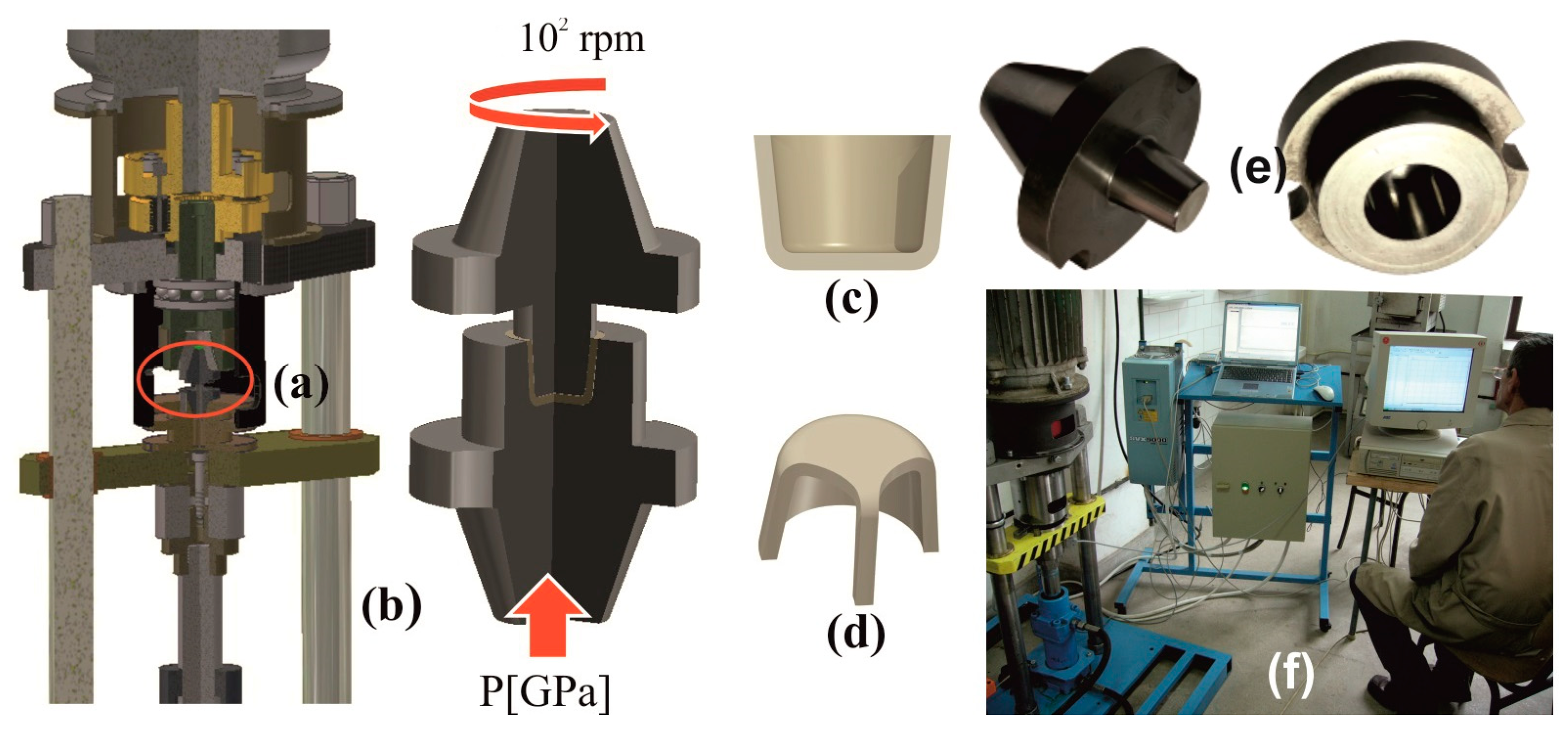
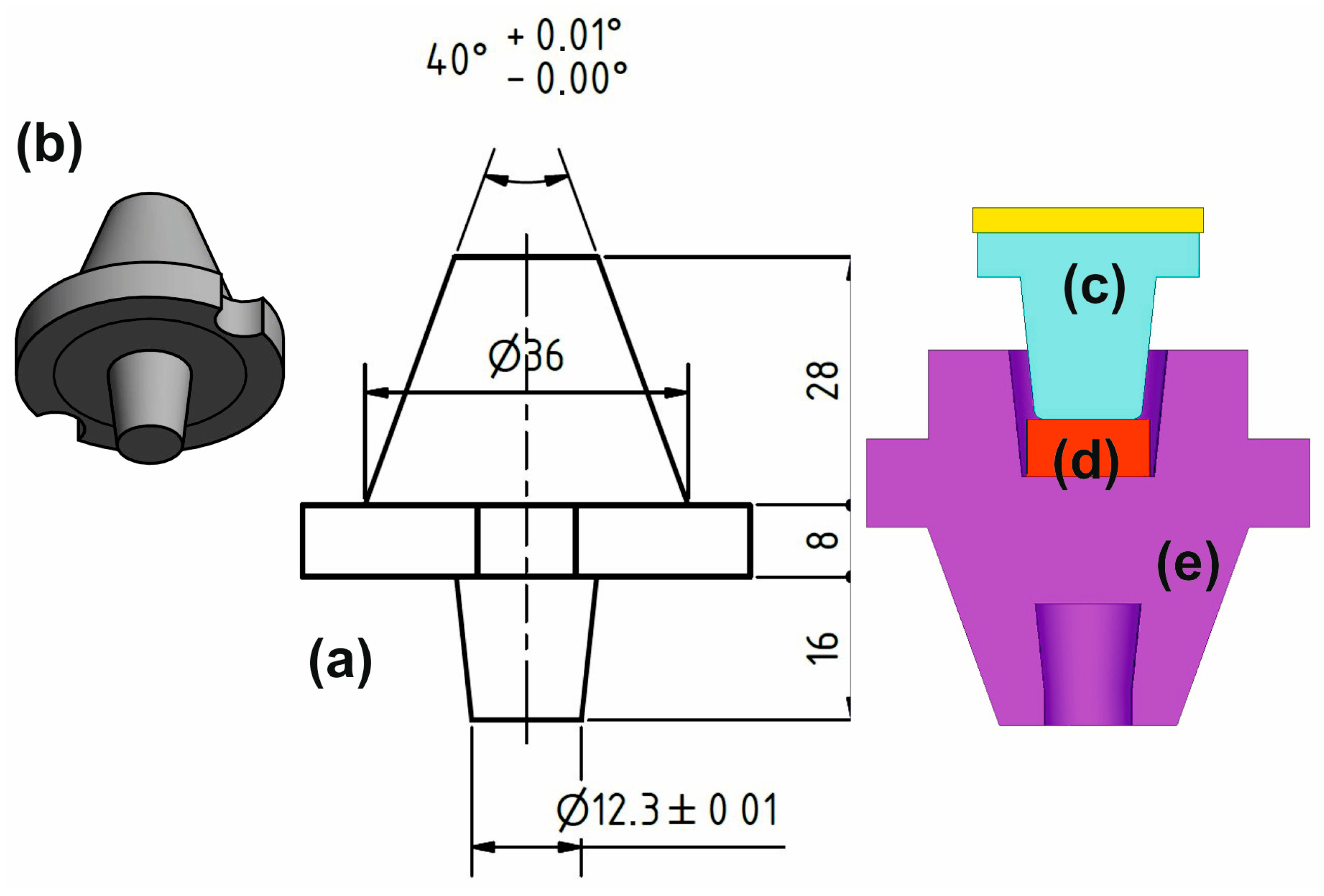
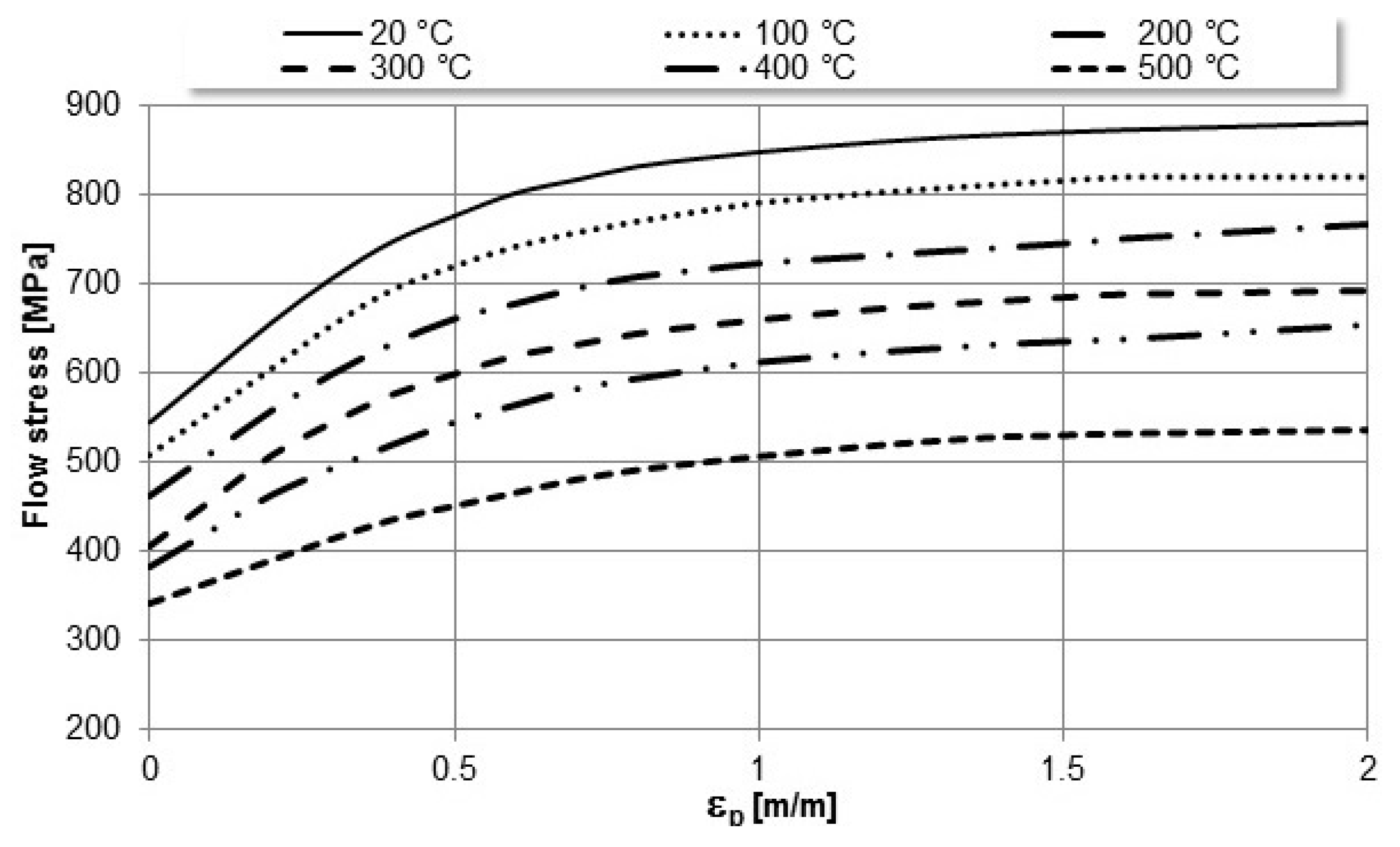

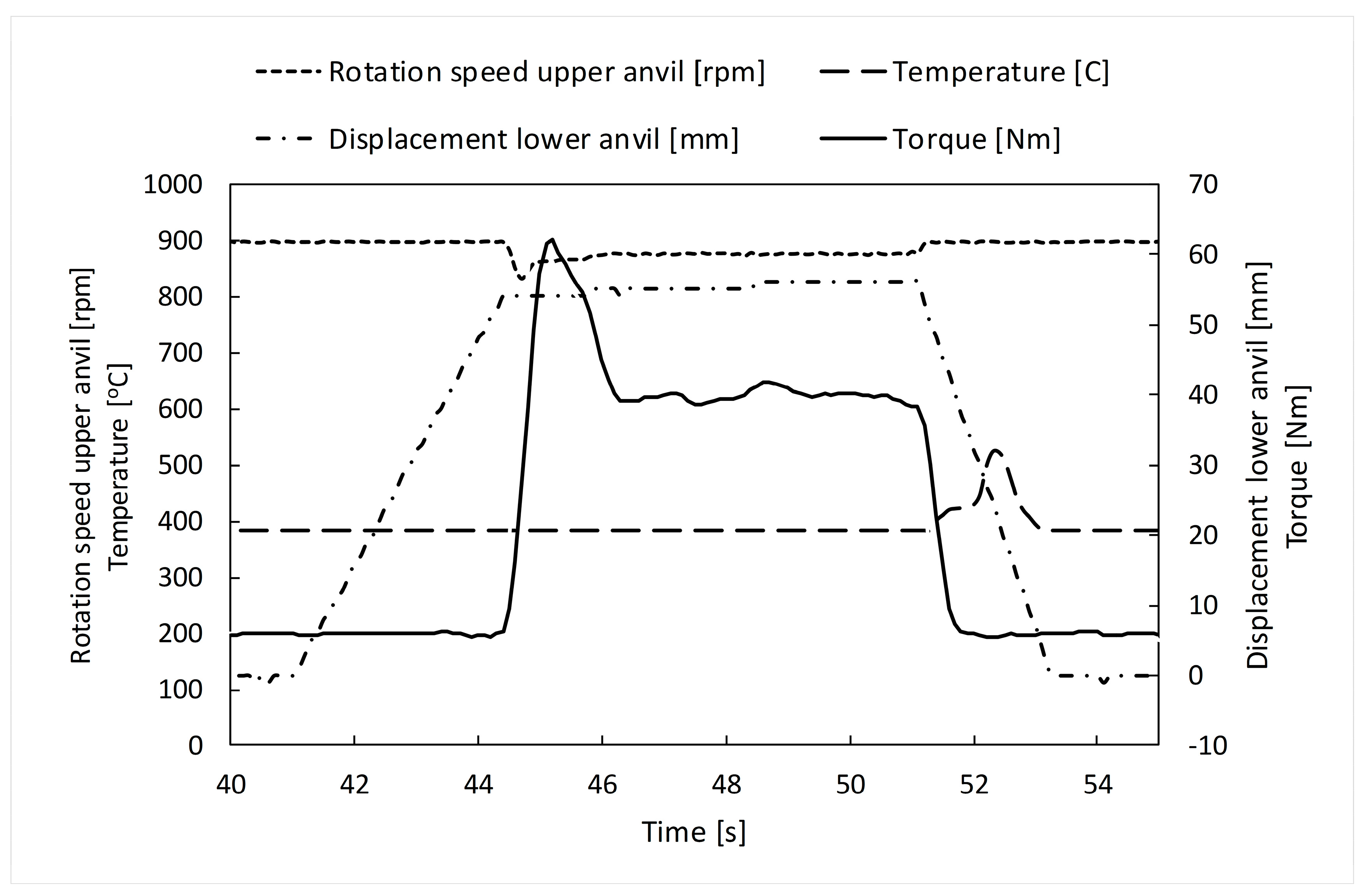

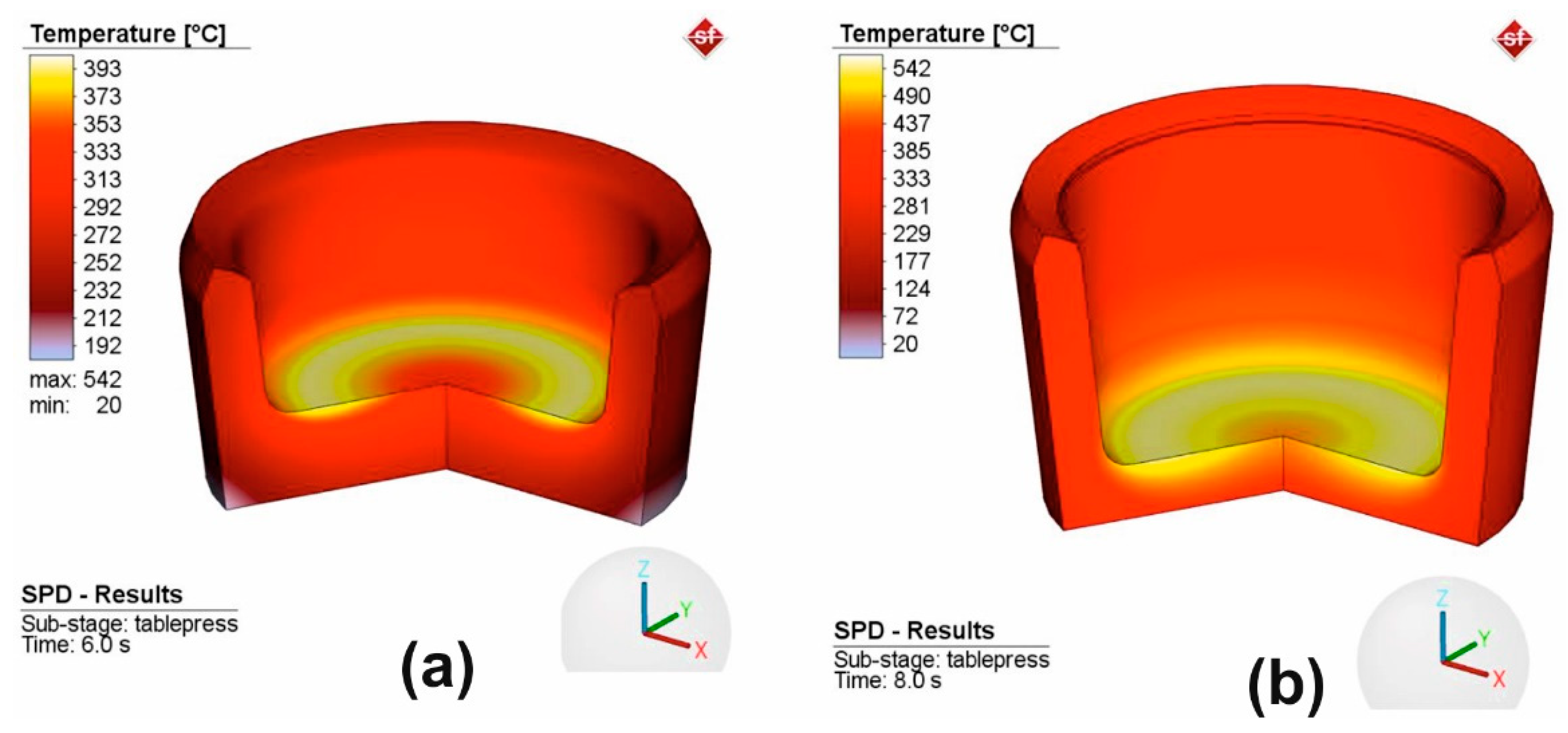
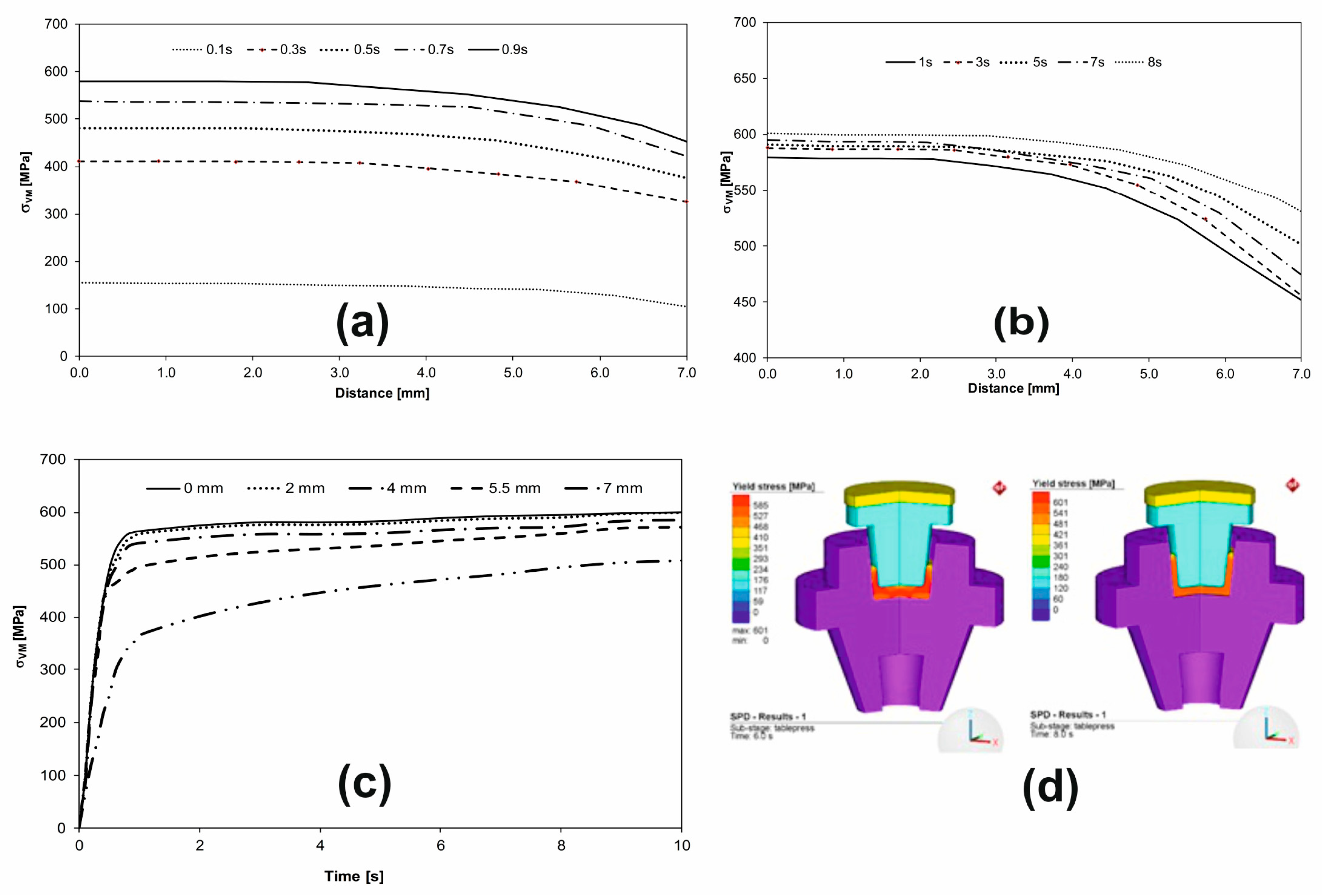

| Element | Ti | Nb | Zr | Ta | Fe | O |
|---|---|---|---|---|---|---|
| Weight (%) | 61.24 | 31.50 | 3.10 | 3.10 | 0.90 | 0.16 |
| Temperature [°C] | 20 | 100 | 200 | 300 | 400 | 500 | 600 |
|---|---|---|---|---|---|---|---|
| E [GPa] | 53.75 | 53.25 | 51.75 | 50 | 48 | 45.75 | 43.25 |
| k [W/(m °C] | 26.7 | 27.7 | 27.6 | 27.4 | 27 | 26.7 | 26.4 |
| Cs [J/(kg °C] | 501 | 536 | 562 | 554 | 552 | 560 | 607 |
Disclaimer/Publisher’s Note: The statements, opinions and data contained in all publications are solely those of the individual author(s) and contributor(s) and not of MDPI and/or the editor(s). MDPI and/or the editor(s) disclaim responsibility for any injury to people or property resulting from any ideas, methods, instructions or products referred to in the content. |
© 2023 by the authors. Licensee MDPI, Basel, Switzerland. This article is an open access article distributed under the terms and conditions of the Creative Commons Attribution (CC BY) license (https://creativecommons.org/licenses/by/4.0/).
Share and Cite
Bîrsan, D.C.; Gurău, C.; Marin, F.-B.; Stefănescu, C.; Gurău, G. Modeling of Severe Plastic Deformation by HSHPT of As-Cast Ti-Nb-Zr-Ta-Fe-O Gum Alloy for Orthopedic Implant. Materials 2023, 16, 3188. https://doi.org/10.3390/ma16083188
Bîrsan DC, Gurău C, Marin F-B, Stefănescu C, Gurău G. Modeling of Severe Plastic Deformation by HSHPT of As-Cast Ti-Nb-Zr-Ta-Fe-O Gum Alloy for Orthopedic Implant. Materials. 2023; 16(8):3188. https://doi.org/10.3390/ma16083188
Chicago/Turabian StyleBîrsan, Dan Cătălin, Carmela Gurău, Florin-Bogdan Marin, Cristian Stefănescu, and Gheorghe Gurău. 2023. "Modeling of Severe Plastic Deformation by HSHPT of As-Cast Ti-Nb-Zr-Ta-Fe-O Gum Alloy for Orthopedic Implant" Materials 16, no. 8: 3188. https://doi.org/10.3390/ma16083188
APA StyleBîrsan, D. C., Gurău, C., Marin, F.-B., Stefănescu, C., & Gurău, G. (2023). Modeling of Severe Plastic Deformation by HSHPT of As-Cast Ti-Nb-Zr-Ta-Fe-O Gum Alloy for Orthopedic Implant. Materials, 16(8), 3188. https://doi.org/10.3390/ma16083188







